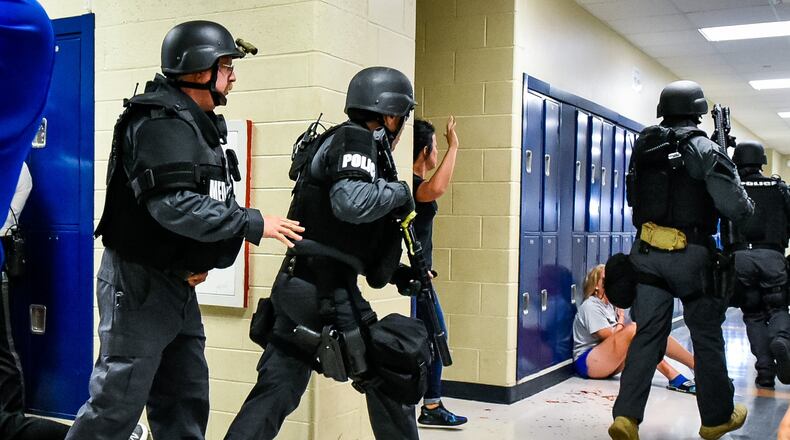But it’s not enough, some school leaders say.
So for the first time in Ohio, school districts have a taxing option that allows multiple school systems to band together and offer the same tax levy issue on a ballot designated solely to upgrade building security.
Half of Butler County’s school districts — Hamilton, Fairfield, Edgewood, Monroe and New Miami — are on the Nov. 6 ballot with a security tax hike that would mean more armed guards in schools and more mental health counselors to help troubled students, some of whom may be potentially violent.
Butler County is only the third among Ohio’s 88 counties — the others being Stark and Brown counties — to see a group of school districts employ the new taxing district option, which was created by a new Ohio law in March.
The proposed security levy — if approved by a majority of voters in the new, combined school tax district — could impact more than 25,000 students, said Chris Brown, superintendent for Butler County Educational Services (BCES), which oversees the new tax district.
“The Butler County school safety, security and mental health levy that Edgewood, Fairfield, Hamilton, Monroe and New Miami district residents will see on the Nov. 6 ballot gives voters an opportunity to directly support safety improvements,” said Brown.
Learning from the deadly shooting massacres last school year that left dozens of students dead in Florida and Texas high schools, local school officials spent the usual slower-paced summer break instead hastily assessing and installing upgraded security measures.
Some districts such as Ross Local Schools, took the extraordinary steps of training dozens of teachers and non-teaching staffers how to treat the trauma of gunfire wounds, using bloody cuts of raw meat to learn how to plug bullet holes in human flesh.
MORE: Ross Schools pursue own local tax for security, other upgrades
Adding to school officials’ sense of urgency was a unique public pressure campaign embarked on by Butler County’s top law enforcement official — Sheriff Richard Jones.
Jones opposes the proposed security levy, contending local schools already have enough money in their current budgets to cover upgrade costs or should do so by re-allocating money.
Shortly after the Parkland, Fla., high school shooting in February, Jones relaunched a public call he had first unleashed in 2013 after the Sandy Hook Elementary School shooting that left 26 students and adults dead.
Jones’ long-standing campaign for getting more armed personnel in local schools — including volunteer, trained school staffers — gained momentum in the last half of last school school year as some Butler County districts hired more armed school resource officers.
Madison Local Schools went further.
Officials in the rural school system, which drew national attention in 2016 when an armed student wounded three classmates, said it plans to allow some trained staffers this school year to have access to firearms to better protect Madison students and employees.
Though officials from the 10,000-student Hamilton City Schools have drawn sharp criticism from Jones — including a billboard posted by Jones’ supporters questioning Hamilton officials commitment to safety — Superintendent Larry Knapp said his district is aggressively fortifying its school buildings with a variety of security measures.
Safer schools are a community effort, said Knapp, and the district has already held a well-attended town hall meeting to determine whether to arm some staffers. The district initially planned on such a move but has since backed off, citing the outcome of the upcoming school security tax vote.
Future security moves will be done with public input, said Knapp.
“The district is in the process of scheduling more town hall meetings so we can continue the transparent approach, gain additional community input, and keep everyone informed,” he said. District officials “look forward to the continued engagement with our community on this extremely important issue, as ultimately the safety levy is a community decision.”
The county’s largest school system — Lakota Local Schools — declined to join the new security tax district but took its own actions in hiring more armed school resource officers for its 23 schools.
Talawanda Local Schools hired more school resource officers as has Monroe Local Schools. Middletown City Schools has upgraded its security staffing, working closely with that city’s police force.
But while more armed officers are vital for enhanced security, said Fairfield City Schools officials, the other component of the proposed security tax is equally important.
The 10,000-student district, which serves students from the city of Fairfield as well as Fairfield Twp., currently has no full-time mental health counselors on its campuses.
Passage of the 10-year, 1.5-mill property tax increase will allow Fairfield not only to hire five mental health counselors but also place armed school resource officers in each of its schools.
And the smallest district in Butler County — the 600-student New Miami Local Schools — sees the new tax option as a rare opportunity to obtain local tax revenue to upgrade security through adding counseling services.
“The district has had a school resource officer on campus since 2003 and has strategically implemented security safeguards for years,” said New Miami Superintendent Rhonda Parker.
“The district has concluded that adding mental health services is a priority to our comprehensive safety plan, so that we may address the needs of our students being impacted by the ever changing societal issues that they face every day,” said Parker.
About the Author
